Varying dietary fat levels (20–28 percent) during the freshwater phase did not influence smoltification or male early sexual maturation during the subsequent grow-out phase
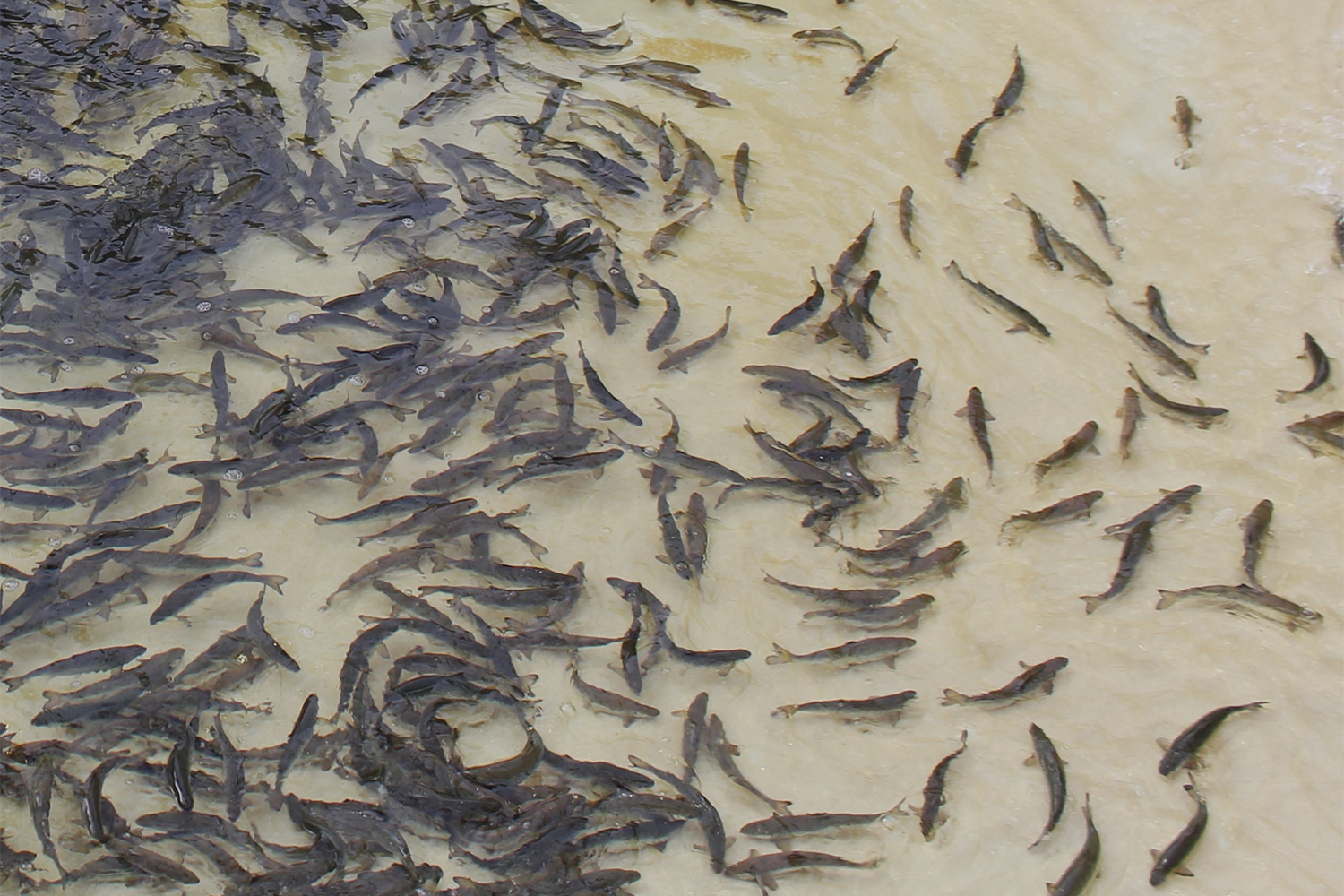
Currently, the most common way of producing Atlantic salmon (Salmo salar) consists of a two-phase production cycle matching the salmon’s anadromous lifestyle. First, parrs (juvenile fish) are produced and smoltified in a freshwater hatchery; thereafter, smolts (seawater-ready fish) are transferred to sea cages for grow-out. During the past decade, freshwater hatcheries have been replaced from conventional flow-through systems to recirculating aquaculture systems (RAS).
RAS are among the most environmentally sustainable systems to culture fish, and in Atlantic salmon production is especially relevant due to the possibility for water temperature control, freshwater reutilization, higher fish densities and larger smolts production. These RAS-controlled production environments result in optimal conditions for fast fish growth and shorter production time. However, there are potential trade-offs between this fast growth and key physiological processes such as inadequate smoltification and early sexual maturation which can ultimately impact the fish health and welfare, and the final product quality including poorer fish fillet quality.
Smoltification or parr-smolt transformation involves a suite of physiological, morphological and behavioral changes such as the development of the osmoregulatory ability that prepares the Atlantic salmon for a life at sea. A few studies have investigated how smoltification is affected by dietary fat levels and how seawater growth can be linked to dietary history and overall concluded that smolt production may not be impaired by a reduction in dietary fat content. However, these studies were conducted under seminatural conditions, using simulated natural photoperiod and fluctuating relatively low temperatures, resulting in slow-growing fish.
In contrast, the intensive rearing conditions in RAS, such as higher temperatures and continuous light and feed promote high metabolic rates and fast growth. Consequently, there is a need to test the interrelationship and possible interference between feed containing different levels of dietary fat during smoltification in RAS, subsequent seawater performance and occurrence of early maturation in Atlantic salmon male fish.
This article – summarized from the original publication (Mota, V.C. et al. 2024. Smoltification, seawater performance, and maturation in Atlantic salmon (Salmo salar) fed different fat levels. Front. Aquac., 25 January 2024, Sec. Production Biology, Volume 3 – 2024) – presents the results of a study to determine the effect of different dietary fat levels on Atlantic salmon whole-body fat and fatty acids (FA) composition, growth performance and smoltification, and to assess the effects of a previous dietary regime on seawater growth performance and early male sexual maturation at two temperatures.
Study setup
This research was carried out at the Tromsø Aquaculture Research Station (Kårvik, Norway). The study determined the effect of i) dietary fat levels on Atlantic salmon whole-body fat and fatty acids composition, growth performance and smoltification and ii) a previous dietary regime on seawater growth performance and male early sexual maturation. In freshwater RAS, salmon parr (~19 grams) were fed three fat levels (20, 24 and 28 percent) over a 14-week period at 12 degrees-C. Subsequently, in seawater flow-through systems, smolt (~96 grams) were fed a control diet (26 percent) for 12 weeks at two temperatures (12 and 16 degrees-C).
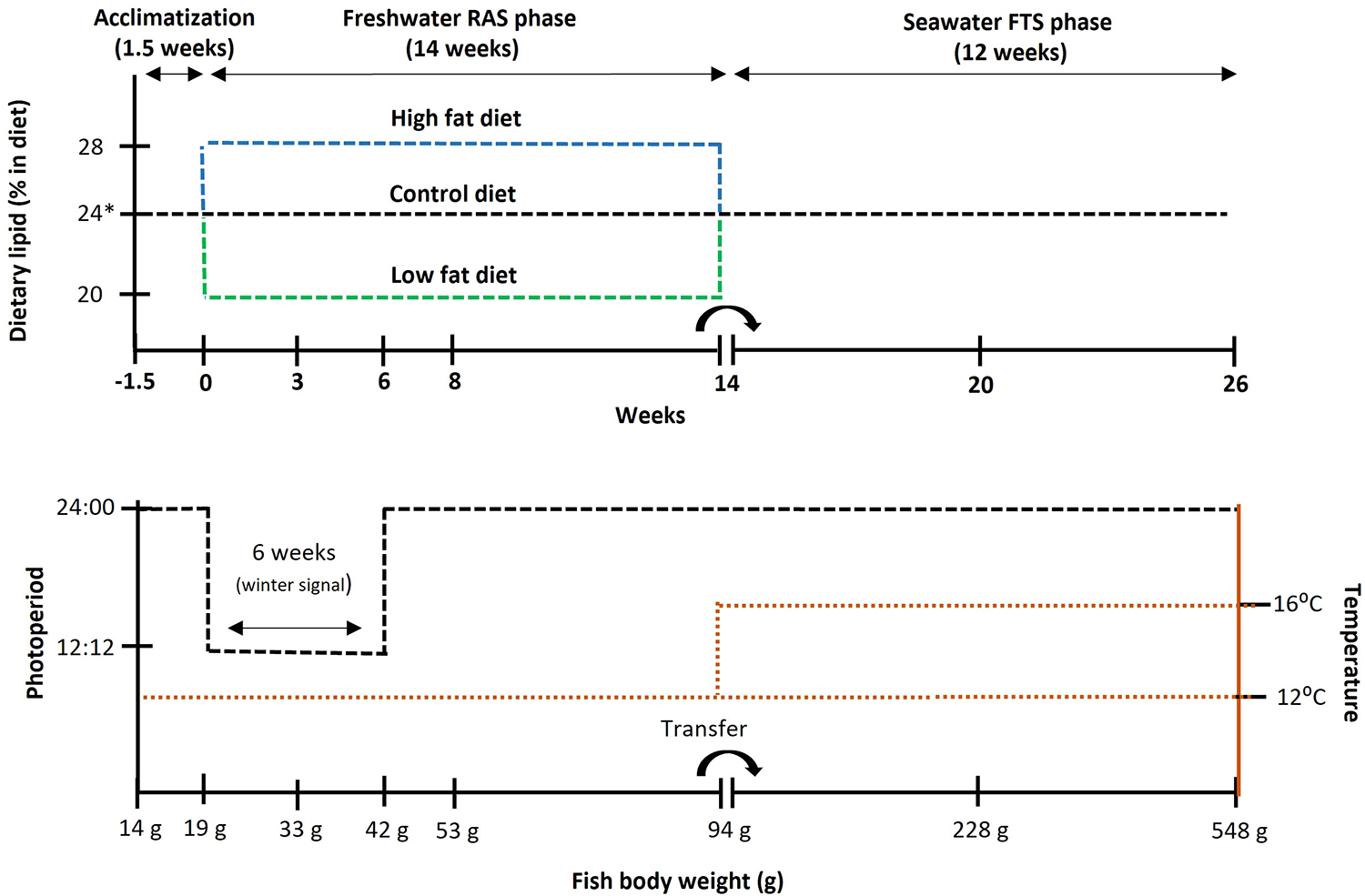
For detailed information on the experimental design and fish rearing and husbandry; formulation of experimental diets; fish sampling and various analyses, refer to the original publication.
From smolt wastewater to algae production: an economic approach on aquaponic production
Results and discussion
Overall survival was high (> 99.0 percent) during both experimental phases. The exception was the Low-fat group during the Freshwater RAS phase, where an acute mortality event occurred after sampling at week eight in one of the replicated tanks, resulting in average treatment group survival of 90.9 percent. The mortality was likely caused by a hydrogen sulfite release from one water pipe during RAS routine maintenance. Fish growth curves show that the body weight was similar among the dietary groups throughout the 26-week experimental period (Fig. 2). In contrast, the body weight in the 16 degrees-C groups was significantly larger by 22 percent and 36 percent at respectively week 20, and week 26 compared to groups grown at 12 degrees-C. Specific growth rate (SGR) for the Freshwater RAS phase did not differ significantly among the dietary groups, while SGR for the Seawater FTS (flow-through system phase was 19 percent significantly higher in the groups grown at 16 degrees-C when compared to the groups grown at 12 degrees-C. The thermal growth coefficient (TGC; a versatile predictor of growth over temperature) did not differ in any of the phases.
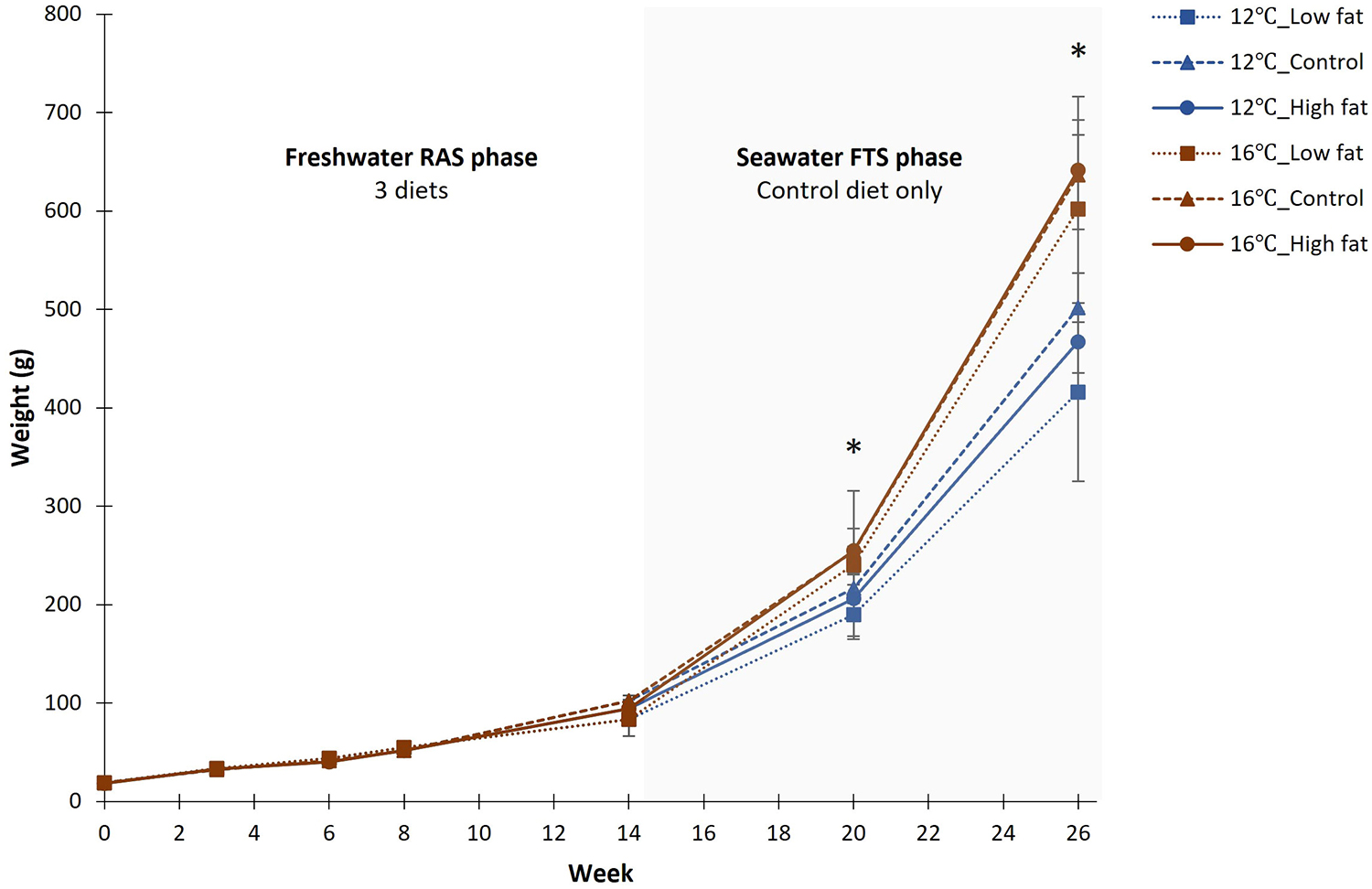
The whole-body fat at the start of the experiment (week 0) did not differ among the three dietary groups (11.3 ± 0.3 percent; Fig. 3). In contrast, at the end of the Freshwater RAS phase (week 14), the whole-body fat from the Low fat group had decreased to 9.0 ± 0.7 percent and was significantly lower, when compared with the Control (11.1 ± 0.7 percent) and High fat groups (12.3 ± 0.7 percent). At the end of the Seawater FTS phase (week 26), the whole-body fat was not significantly affected by the dietary history of the fish. On the other hand, fish grown at 12 degrees-C had significantly lower whole-body fat (14.4 ± 0.1 percent) when compared to the fish groups grown at 16 degrees-C (15.6 ± 0.4 percent).
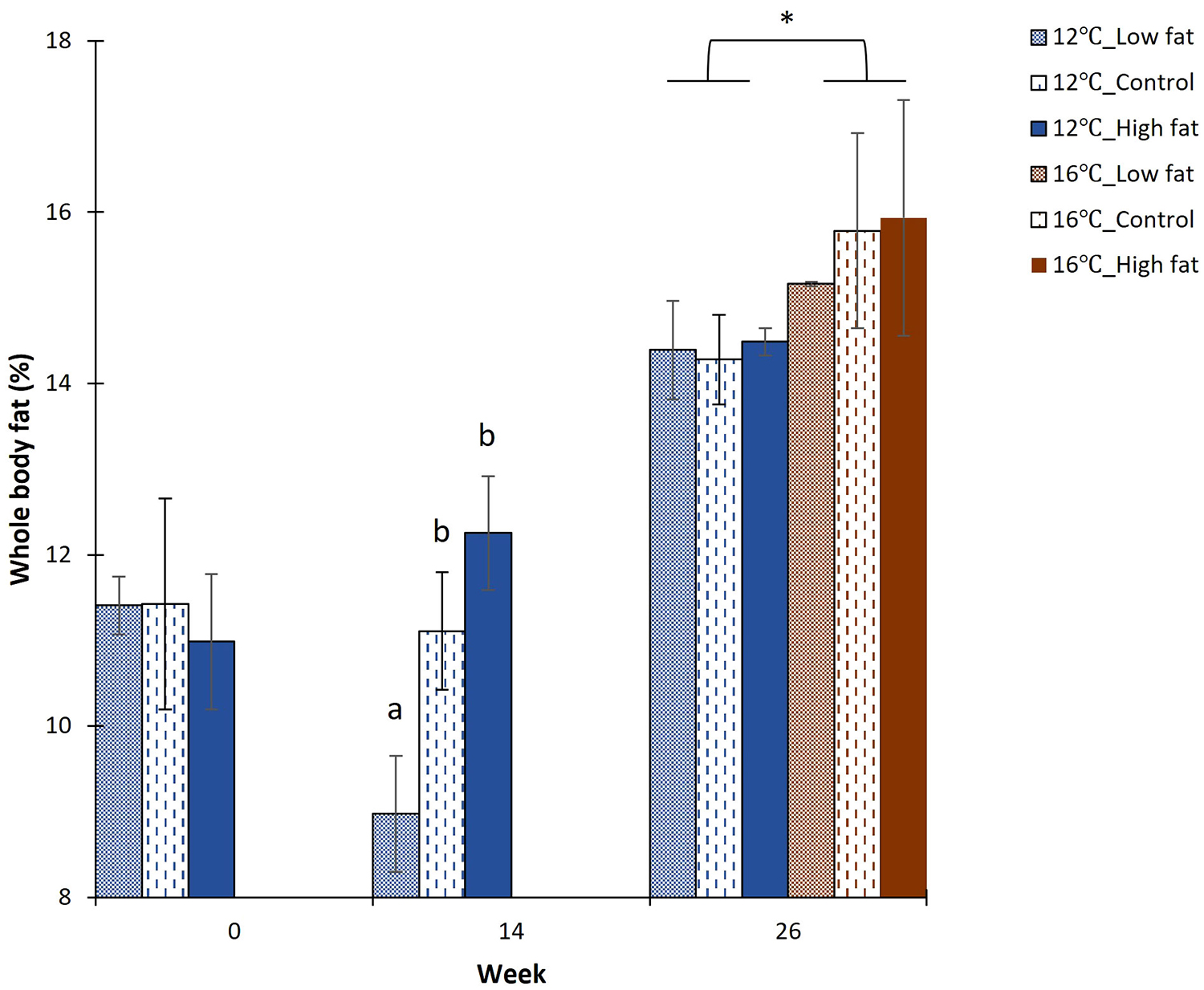
Continuous feeding, constant light and relatively high temperatures applied in current day RAS facilities to produce smolts may interfere with smoltification and promote precocious maturation. In the present study, we investigated the influence of different dietary fat levels (Low fat 20 percent, Control 24 percent and High fat 28 percent) on smoltification in RAS and subsequently their long-term effects on outgrowth and sexual maturation in seawater FTS. We found that condition factor (k-factor, relating length and weight of fish), whole-body fat and fatty acids composition differed significantly among groups, whereas growth, smoltification and other indicators were unaffected by the diets.
Testes histology showed most testes as immature (stage I) with some testes maturing (stage III) without clear effect of diets or temperature. However, fish body weight and sex steroid androstenedione were positively affected by temperature but not by diets at the end of the Seawater FTS phase.
All diet groups showed similar whole-body fat at the end of the seawater-FTS phase, regardless of the earlier phase differences. This finding suggests that smolts that were initially low on body fat level were able to regain the fat level and thereafter maintain it similarly to the other two diet groups at a maximum lipid load as it has been postulated previously for salmonids. Yet, feed intake was not monitored in this study and possible differences in energy intake due to different feeding activity cannot be ruled out.
Temperature was previously shown to influence fat accumulation, where lower temperatures (5–6 vs 12 degrees-C) result in a higher accumulation in the liver. The whole-body fish fatty acid (FA) composition had some minor differences among groups, but the total FA classes – saturated fatty acids (SFA), monounsaturated fatty acids (MUFA) and omega-3s – were not different among the three diet groups. These results suggest that despite different fat level in the diets during the freshwater phase, the content in FAs likely was within the fish requirements, and therefore no major differences were observed at the fish body composition level.
Dietary effects on smoltification have been studied in fish fed different diets through the development from parr to smolt. In the current study, fish were smoltified and grown in RAS units until approximately 90 grams and most smoltification markers measured indicate that fish had smoltified independently of their fat diet regime. The exception was a lower condition factor (k-factor) on the Low Fat diet group. The reduction of the k-factor is a typical result of the increase length growth relative to body mass during smoltification, and whether this observation in the Low Fat group is a result of the lower diet fat content or a sign of strong smoltification is not clear.
In the seawater phase of Atlantic salmon aquaculture average mortality is 16–17 percent. A high proportion of this mortality occurs in the first months after smolts have been transferred to sea cages. Similarly, in the current study fish fed during the freshwater to diets varying on fat composition performed equally well in the seawater phase, with no mortality, similar growth rate and final whole body fat composition. These findings support earlier findings that poor performance after seawater transfer may not be the result of current commercial diets.
Maturation in Atlantic salmon is known to be influenced by factors such as photoperiod, water temperature, exercise, genetic strain, rearing water quality and feed, with water temperature and photoperiod appearing to be the most critical factors for the decision to start of delay maturation. In the present study, no differences in male precocious maturation were observed among the dietary groups, assessed by blood serum sex steroid levels or histological analysis of the testis. In contrast, males reared at 16 degrees-C resulted in higher level of the sex steroids androstenedione compared to 12 degrees-C.
Perspectives
The current study showed no effects on smoltification, seawater performance and maturation of a low (20 percent) and high (28 percent) diet fat levels compared to a control (24 percent) fat diet (similar to a commercial feed). In contrast, whole-body fat and FA composition differed among dietary groups in the Freshwater RAS phase. Moreover, fish grown in a seawater FTS at 12 or 16 degrees-C for 12 weeks until approximately 416–637 grams did not result in a difference in maturation in the male gonad histology evaluation, despite some maturing testes. However, the sex steroid androstenedione levels may indicate an onset of maturation of some fish culture at 16 degrees-C.
Overall, these results indicate that no positive effects may arise from changing modern diets fat levels on smoltification, seawater performance and maturation, but this study’s results also show that it may not be advisable to culture Atlantic salmon at high temperatures due to the risk of male early sex maturation.
Now that you've reached the end of the article ...
… please consider supporting GSA’s mission to advance responsible seafood practices through education, advocacy and third-party assurances. The Advocate aims to document the evolution of responsible seafood practices and share the expansive knowledge of our vast network of contributors.
By becoming a Global Seafood Alliance member, you’re ensuring that all of the pre-competitive work we do through member benefits, resources and events can continue. Individual membership costs just $50 a year.
Not a GSA member? Join us.
Author
-
Dr. Vasco C. Mota
Corresponding author
Nofima AS, The Norwegian Institute of Food, Fisheries and Aquaculture Research, Tromsø, Norway; and Department of Mechanical Engineering and Technology Management, Norwegian University of Life Sciences, Ås, Norway
Tagged With
Related Posts
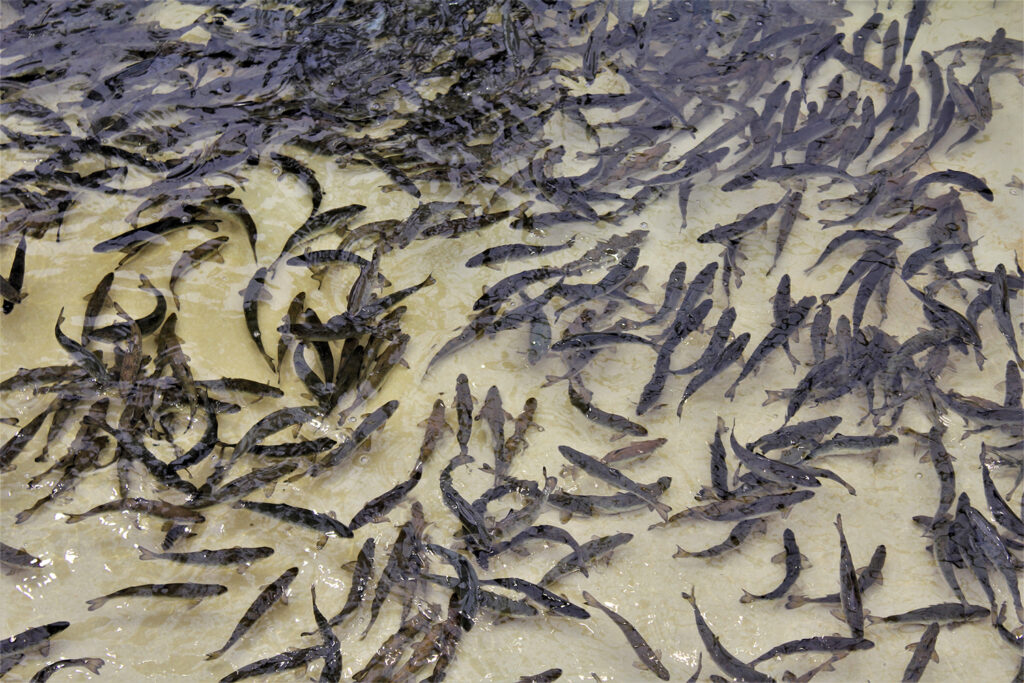
Health & Welfare
Assessing the effect of photoperiod manipulation on Atlantic salmon growth, smoltification and sexual maturation
Evaluation of photoperiod influence on salmon smolts suggests that an artificial winter signal would benefit RAS post-smolt production.
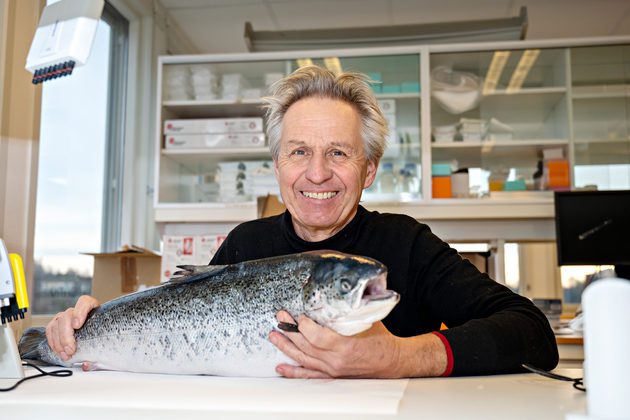
Health & Welfare
Nofima unlocks ‘promising’ method for sterilizing farmed salmon at embryotic stage
A new technique for sterilizing farmed salmon at the embryonic stage could limit the impact of escaped farmed salmon in rivers.
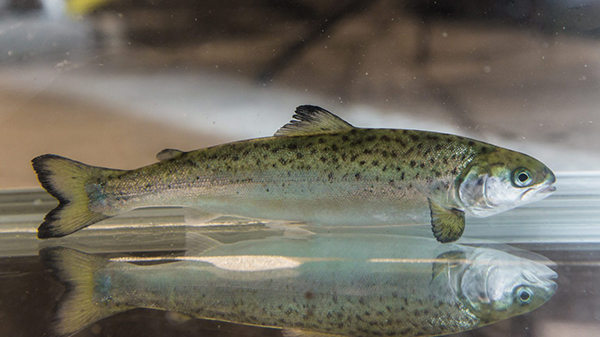
Health & Welfare
Health test for salmon smolt may improve survival chances
Nofima scientists have developed a test that measures the immune status of salmon smolt that could increase the smolts’ chances of survival.
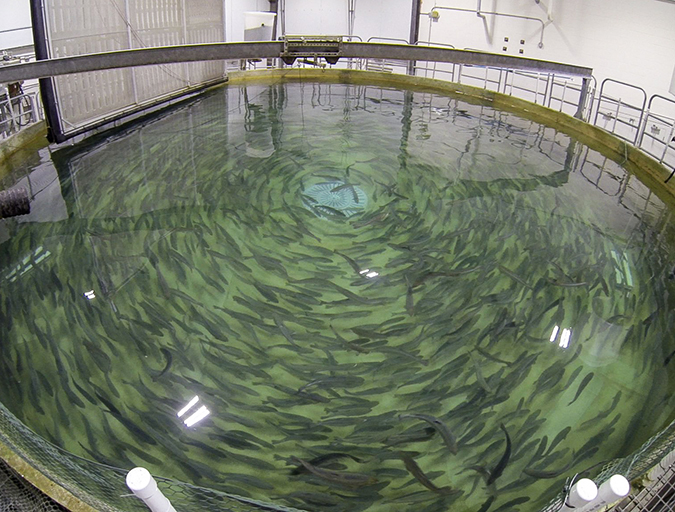
Innovation & Investment
Getting proficient in RAS fundamentals
A number of large salmon farming companies are now investing significantly to increase land-based, water recirculating aquaculture systems (RAS) in northern Europe and North America, and there is likely a need for more trained farm personnel to run and manage these and other close-containment aquaculture facilities.



